The terminator is predicted to be just west of Capella, and the LRO puts the penumbra edge in the same location. The composite image shows Capella’s crater walls are lit, which puts the Apollo picture of the terminator also to the east of it.
Later in the mission we move to Magazine D, where we have some much more easily interpreted data in the form of photographs taken looking straight down. We also have a very good record of when the terminator photographs were taken because they are specifically referred to in the transcripts as being during rev 4. As rev 4 the spacecraft passed over the terminator on the far side at 75:10, we have a precise time to use to set, namely 16:01 on the 24th. The image below shows the new location of the far side terminator.
Even though it has only been a few hours since the first orbit’s images of the far side terminator it has moved noticeably, and more importantly the Apollo photographs show that terminator in the correct place. It’s interesting to compare this with similar shots from Magazine C, which provided the forward looking stereo shots compared with Magazine D’s vertical shots.
Magazine C was shot with f-
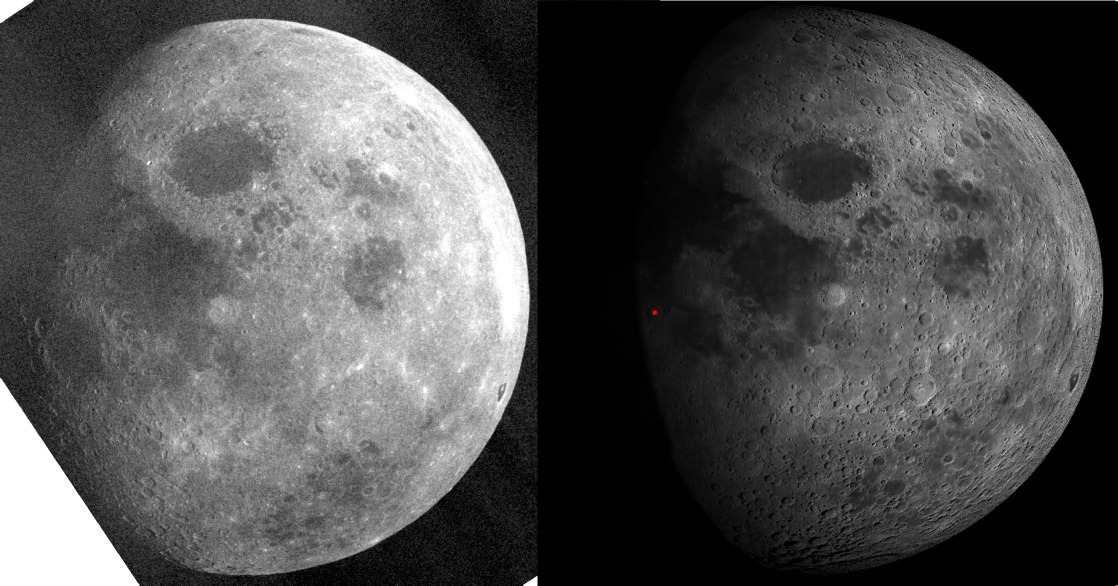
So, we have a magazine of photographs of the lunar surface that ends with images of a receding moon, on which we can see a terminator whose position matches exactly what should be seen at around TEI on 25/12/68.
Apollo 10
Like Apollo 8, Apollo 10 took vertical and oblique photographs around the terminator area which should allow us to verify when they were taken. There were also some 16mm strips, and as one hoax believer has an issue with those, we’ll take a look at the end of this section to address his concerns.
Much of the early part of the mission was pre-
There were, however, some TV broadcasts, and as part of an extended one early in the mission we have a specific mention of the terminator around the region of Moltke, not far from the Apollo 11 landing site. The view below shows a still from that TV broadcast, made at around 02:00 GMT on 22/05/69, compared with the terminator location that would be expected at that time depicted by the LRO.
One area where we have a definite time marker comes from the TV broadcast during which the crew read from the first chapter of Genesis, a reading that ended just as they began to cross the nearside terminator.
In the mission transcript, the Public Affairs Office (which acted as ‘translator’ explaining the various technical data to the assembled journalists) explains that the camera is looking northwest across the Sea of Tranquility towards some mountains. The broadcast occurred just short of 03:00 GMT on Christmas Day 1968, and the image below shows the LRO view of the Mare Tranquilitatis area compared with a screenshot from the Christmas broadcast.
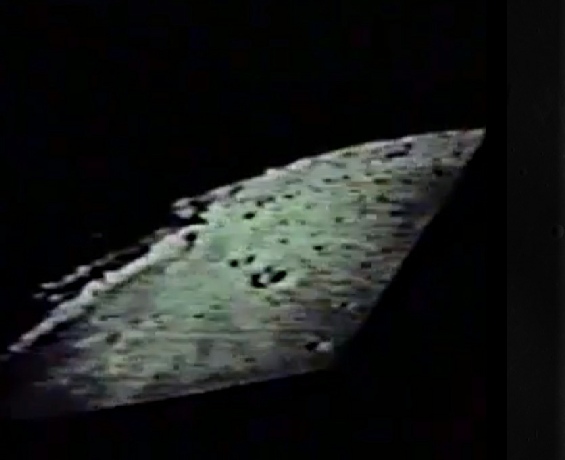
The view seems to correspond well with a view across Sinas crater (the largest one in the centre of the TV view) and the mountain range east of Carrel crater.
As a final view of the terminator, we can look at where the terminator shortly after TEI as the moon recedes into the distance. AS08-
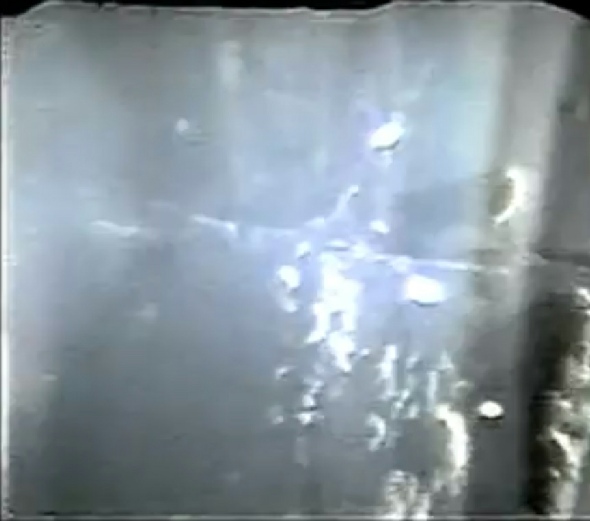
The camera is looking backwards, and Moltke crater can be identified quite easily, as can the long straight feature that Apollo 10 jokingly referred to as ‘Highway 1’. Some conspiracy theorists like to think this is a deliberate reference to artificial alien engineered roads. It is no such thing.
Although they are now entering lunar darkness (referred to as a lunar sunrise because it is the part of the surface emerging into sunlight) there are still relatively bright features to be seen thanks to them adjusting the f-
We have another view of the lunar terminator from early in the mission in Magazine F of the 16mm cameras. We know it must be early in the mission because later on in this magazine there is Earthrise footage that has been timed by research on this site at 23:14 on the 22nd.
The first part of the magazine shows a view of Icarus crater just beyond the terminator line, followed by sequences of Keeler and Curie craters. The next crater shown is Green, which is further east than Curie, and must therefore have been filmed on the following revolution. After Green comes a view of King, and then comes the Earthrise view.
It therefore looks as though the initial terminator view must be (at least) 1 orbit before the Earthrise, and a time of around 21:00 would not be an unreasonable one to use. The image below shows where the terminator would be at that time, compared with a screenshot from magazine F.
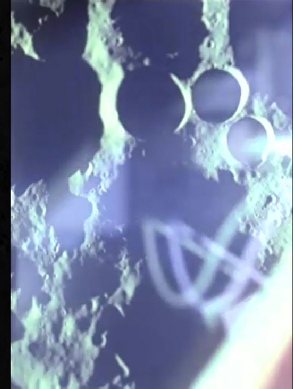
The triplet of craters in the 16mm still are next to Krasovskiy P. I shouldn’t have to point it out, because anyone with a brain could figure it out, but the LRO base map is not lit correctly in terms of these images, the sun is coming from a different direction. The terminator line, however, is correct. Not much doubt on this pass that the strip photography commences shortly after the terminator, and that the terminator is in the right place.
While the Hasselblad strip stops short of an entire daylight transect, the 16mm footage continues unbroken until it reaches the craters of Theon Senior and Junior. It then cuts to an oblique view looking towards the sun and lunar horizon with craters Ritter, Sabine and Schmidt in the foreground. The figure below shows that they were around 250km short of the terminator compared with the final two shots of that pass. It seems likely that this rearward looking view is from the same orbit as the crew pass on this message:
"we have a beautiful panoramic view looking back from Sabine and Ritter"
And shortly afterwards
“we are looking at him now back from Sabine and Ritter"
‘Him’ being Schmidt crater, and they are jokingly referring to Harrison Schmitt, the geologist turned astronaut who landed with Apollo 17.
It’s worth noting that the vertical shot has had to be flipped horizontally, because the camera was mounted to look at a mirror reflecting the view through the window, while the shot of Ritter and Sabine is the right way round, and was obviously hand held.
Shortly after discussing the rear facing view, they complain that it is getting dark and the setting sun is blinding them. The image below shows shots from the video compared and the LRO view.

Icarus and Icarus D can be seen at the top of the 16mm still, with the craters to the east of them kist about to disappear into darkness, exactly as the LRO model predicts.
After this broadcast things get a little busy for the crew, and we don’t get another real chance to see the terminator until the 23th when they begin strip photography from terminator to terminator.
There are a number of magazines showing continuous strips, and neither the transcripts nor the supporting documents make any explicit references as to which magazines are used. We can, however, do a little detective work. The transcript confirms the recorded timeline that strip photography began at 16:09 on 23/05/69 with the crew reporting that:
“We’re taking our vertical strip photography now”
and reporting a short while later at 16:49
“We shot the whole strip...and we got Hasselblad all the way too”
Magazine C, which contains 16mm film, features footage of most of an orbit from just after the far side terminator just north of Lipskiy crater, and there is a corresponding sequence of identically lit 70mm photographs in Magazine O.
More significantly, both film and still sequences show the view rotating 180 degrees as the CSM performs a manoeuvre. And this is referred to directly by the ground:
"we noted that on the last pass during the strip photography, you rolled 180 degrees"
So we can be pretty certain that Magazine O and C took the strip starting at 16:09 on May 23rd.
The figure below shows where the far side terminator should be at this time, Magazine O superimposed on Google Moon, and a 16mm video still from Magazine C.
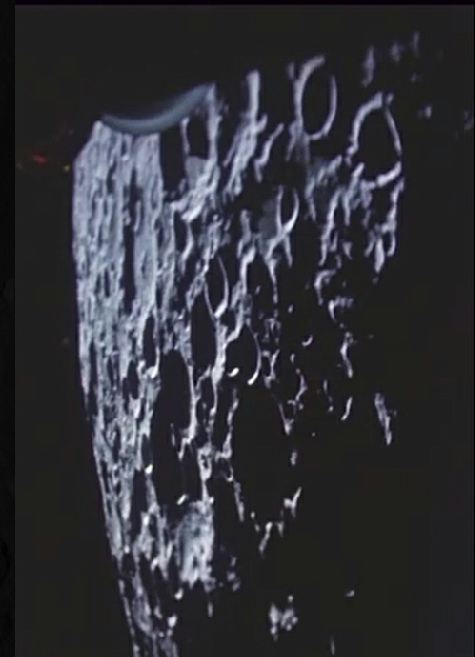
As well as 16mm views of the nearside terminator, we have one from a Hasselblad still. Magazine R has considerable coverage of the nearside, and ends at Rhaeticus, which is where the terminator is predicted to be at the time it was taken (17:37 pm the 23rd) , and is another magazine identified as being used for stereoscopic photography. The images below show where the terminator should be at this time.
Magazine S also has a view of the nearside terminator taken as part of a short strip of images. As usual in this mission, there is no specific mention of which magazine is being used, but the position of the terminator makes it likely that magazine S is the one. Magazine S seems to consist of several separate orbits, and the vertical strip at the nearside terminator is the 2nd of these.
The figure below shows the strip superimposed on Google Moon, and the last of the vertical images in this magazine show Rhaeticus crater, which was close to the terminator the previous afternoon, but is now in early morning lunar daylight.
The last images of this particular orbit are taken obliquely, and is shown to the right, illustrating that the terminator is now between Mosting and Oppolzer craters. The yellow line on the Google Moon screenshot shows the approximate position of the terminator as given by the LRO.
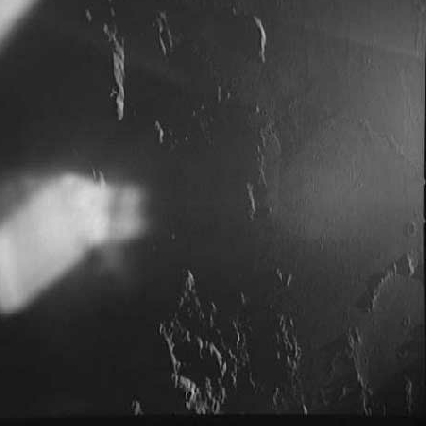
I chose 06:30 as this is part of the way through a session of target of opportunity photography. Rhaeticus crater is obviously much better lit now, so it can’t have been taken at the same time as the equivalent view in Magazine R. The cross in LTVT’s view is Mosting crater.
There is a 16mm magazine (W) that shows similar scenes to those in Magazine S, starting with an almost overhead shot of Sabine and Ritter (left) that compares well with a similar view in Magazine S (right) taken on the same orbit as the vertical shot of Rhaeticus.
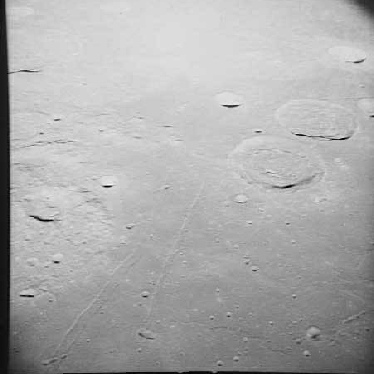
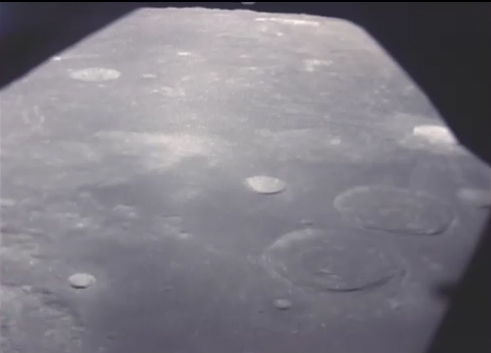
The position of the shadows within the craters suggests very strongly that the 16mm footage was taken either on the same orbit as, or one very close to, the still image.
As far as the terminator end of the footage is concerned, the last discernible feature is Oppolzer (to the west of Rhaeticus), after which the light reflected from within the CSM becomes more prevalent than the light reflected from the lunar surface.
The view here shows the LRO view at this time, but on this occasion the settings are optimised for smoothness, not sharpness, to illustrate the landscape.
The next views of Earth are after the TEI burn on the way home, and as a final check we can quickly make sure that the view of the lunar terminator is what it should be. TEI took place at 10:24 on 24/05/69, and this image is obviously taken sometime after that. It’s worth pointing out that the magazine from which that photograph is taken has several Earthrise photographs that can be dated precisely, so we know that the photograph was taken between specific dates and isn’t just some random image of the moon.
I’ve picked a time of 13:00 on the 24th just for the sake of argument, and the comparison with the LRO is shown below.
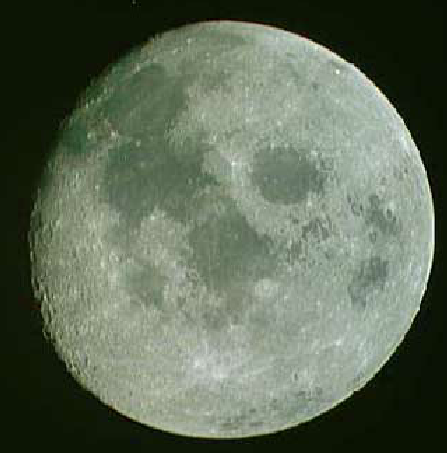
Is the terminator in the right place? Yes, it is. Is this a surprise? No, because we went to the moon.
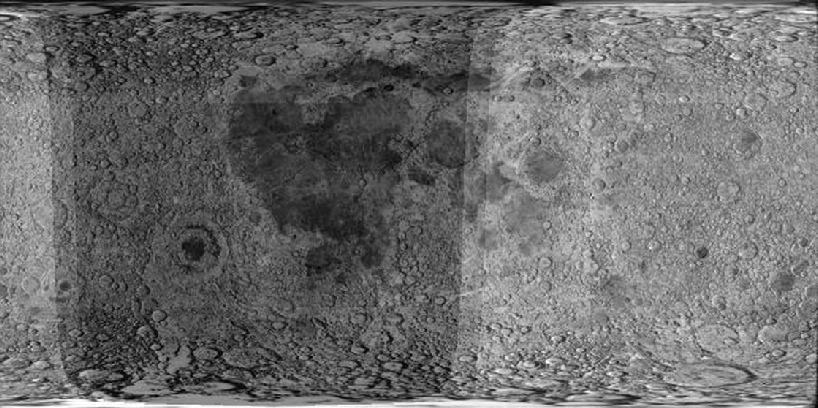
Examining my Google ‘Apollo Moon’ files shows that 4 magazines feature terminator photography.
Magazine G is first mentioned in the early part of the lunar phase of the mission, and a photograph of target of opportunity 10 (Doppler crater) is mentioned at 71:13:20 (12:04 GMT) which puts it in the first full orbit. Preceding that are a number of images taken at the far side terminator. The image below shows a Google Moon view on the left with the yellow line illustrating the terminator line derived from Fourmilab. Superimposed on the screenshot are a couple of Apollo photograph overlays (AS08-
Meanwhile on the other side of the moon, we have the use of magazine E for terminator photography. At just over 70 hours the crew report photographing another of their targets of opportunity, Capella crater, a time that still puts them on rev 1.
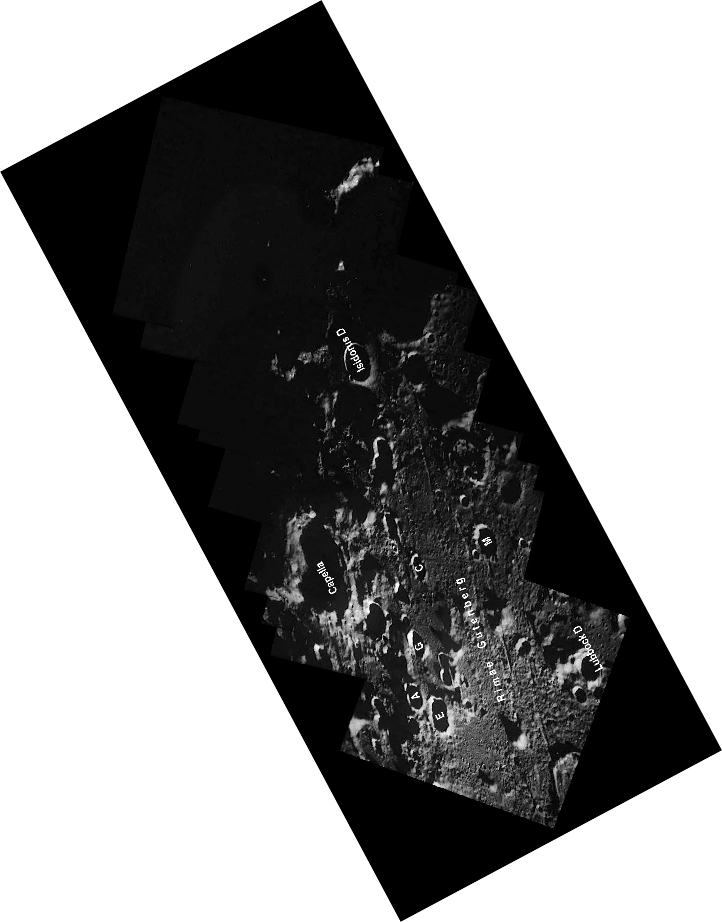
The images comprising this photomontage are AS08-
The AFJ have produced a nice composite of the terminator around this time showing Mechnikov crater using pictures AS08-
Again, te composite has been rotated to the correct orientation.
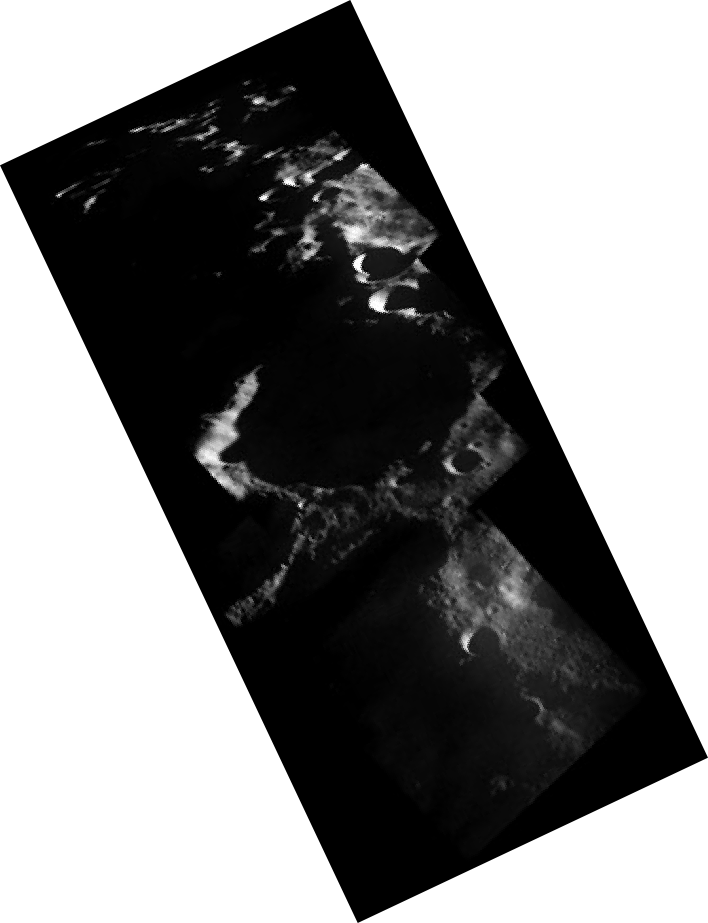
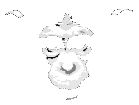


Apollo 8
Apollo 8 only carried out 10 orbits during it’s brief stay, but even that interval is enough for the terminator shadow to move considerably over the lunar surface. The image below shows the difference in the terminator between LOI (Lunar Orbit Insertion) and TEI (Trans-
The AFJ has done another fine composite of a series of photographs from that part of the orbit showing Capella crater in its regional context, and the terminator position is pretty clear.
The composite has been rotated to the correct orientation.
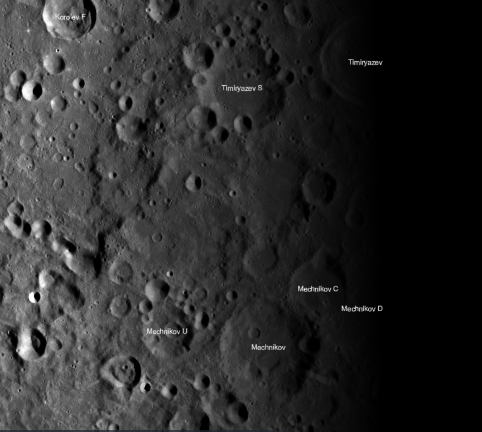
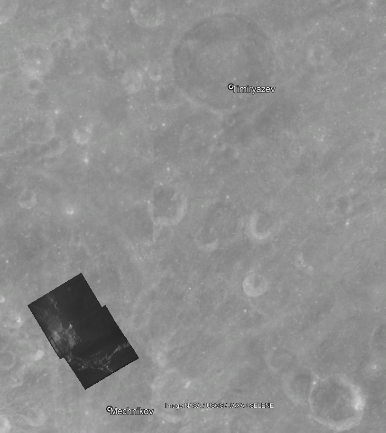
The photographs show part of Mechnikov crater, which predictions of the lunar terminator suggest would be in lunar twilight, which indeed is what the Apollo photograph shows.
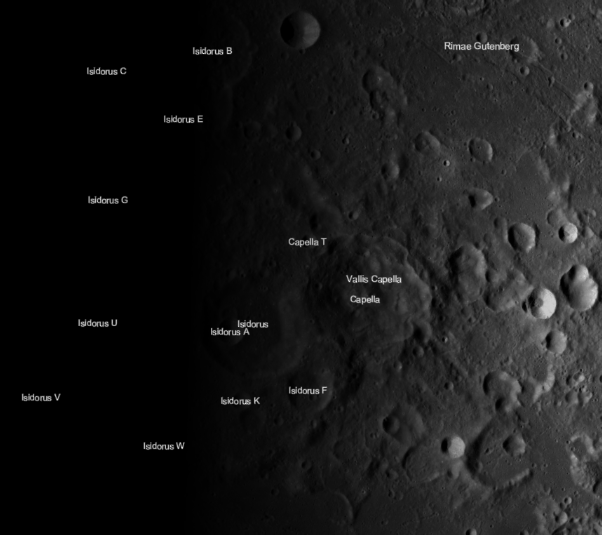
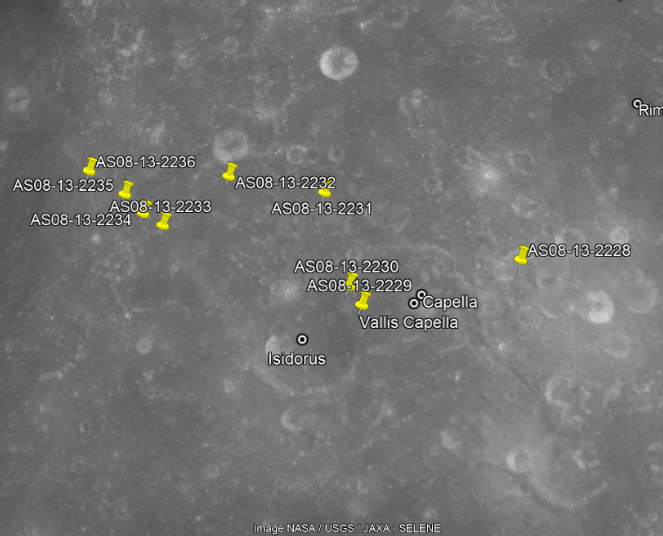

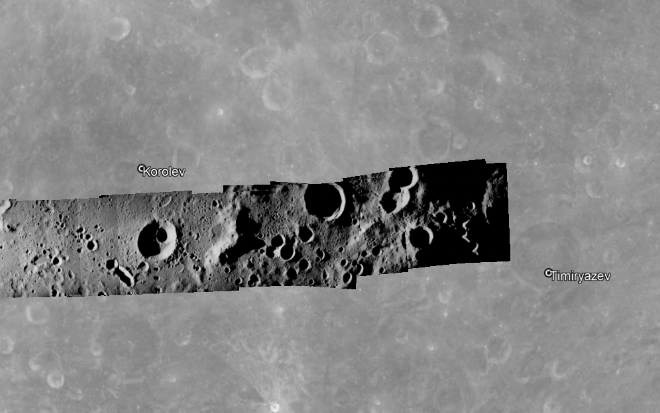
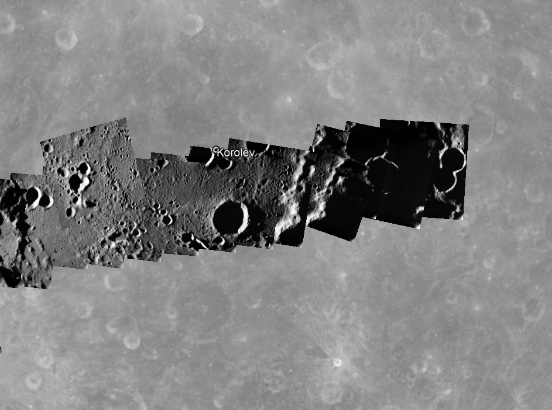
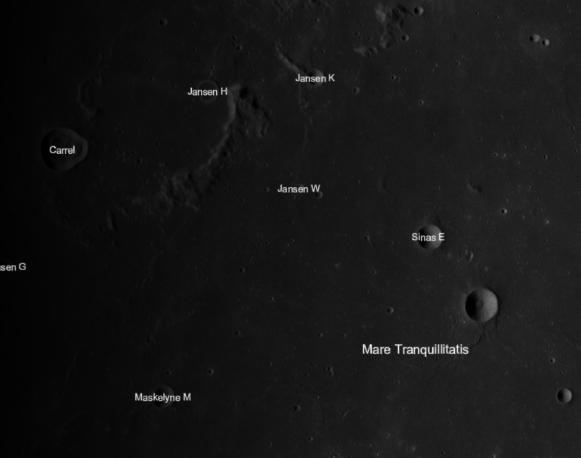
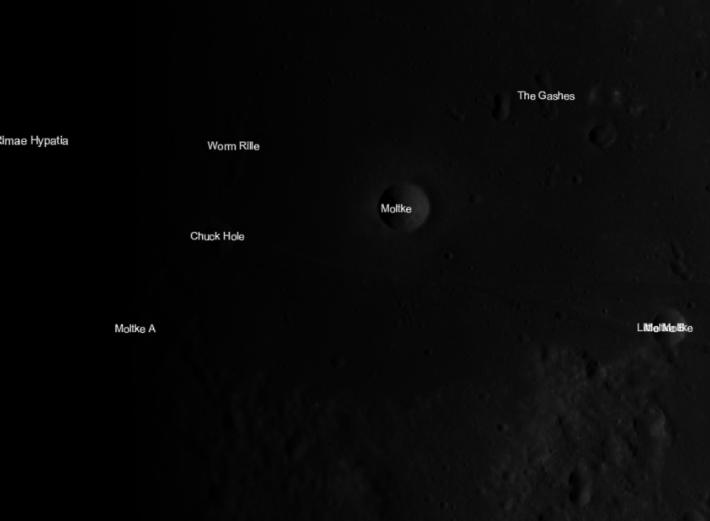
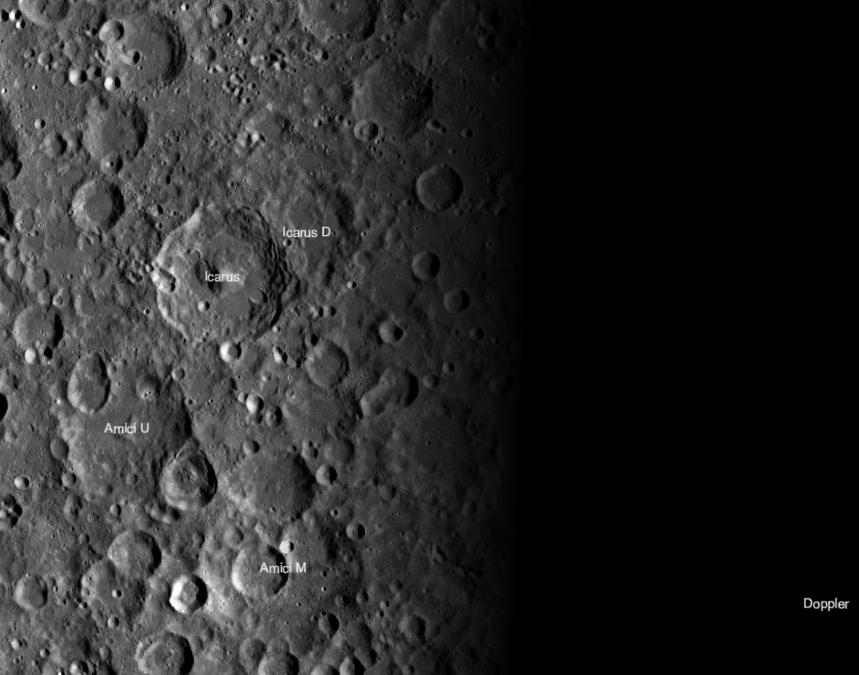
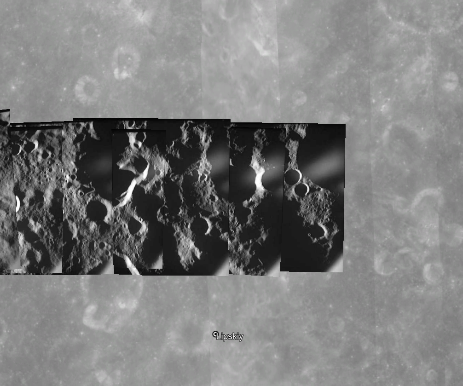
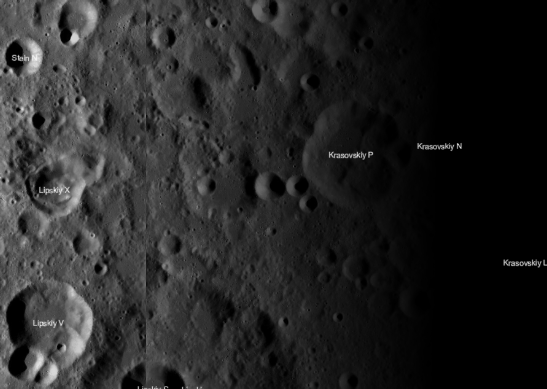

The edge of the crater at the top of the 16mm still is Theon senior, northt w est of Delembre..
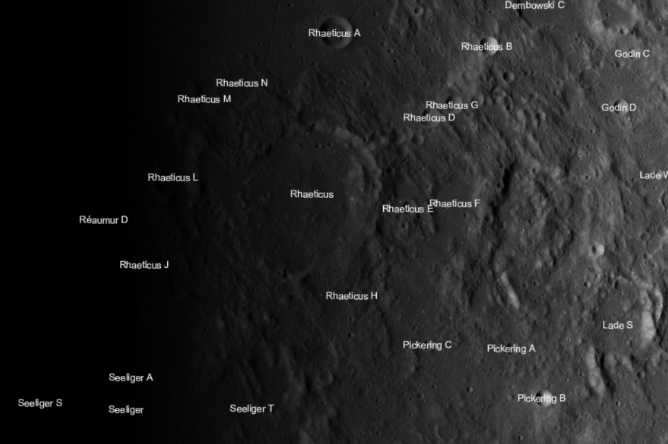
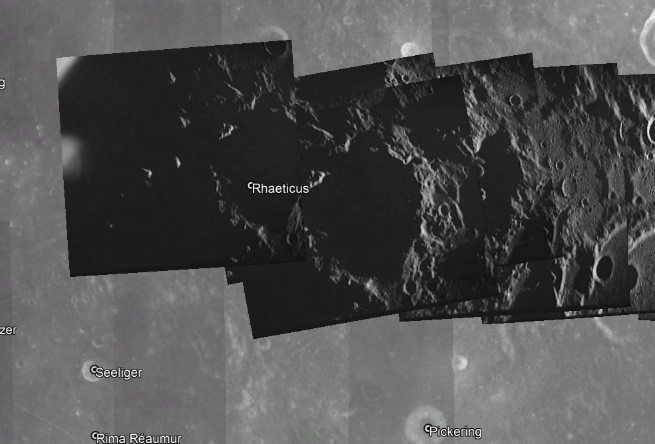
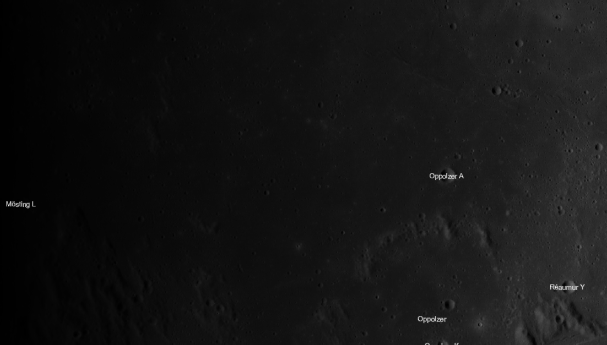
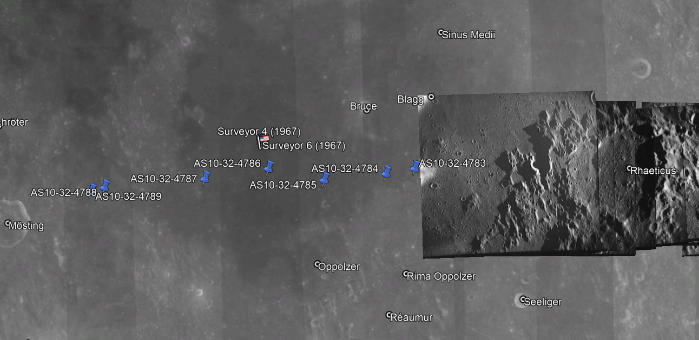
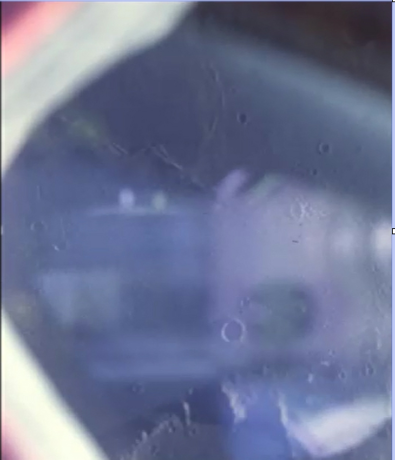
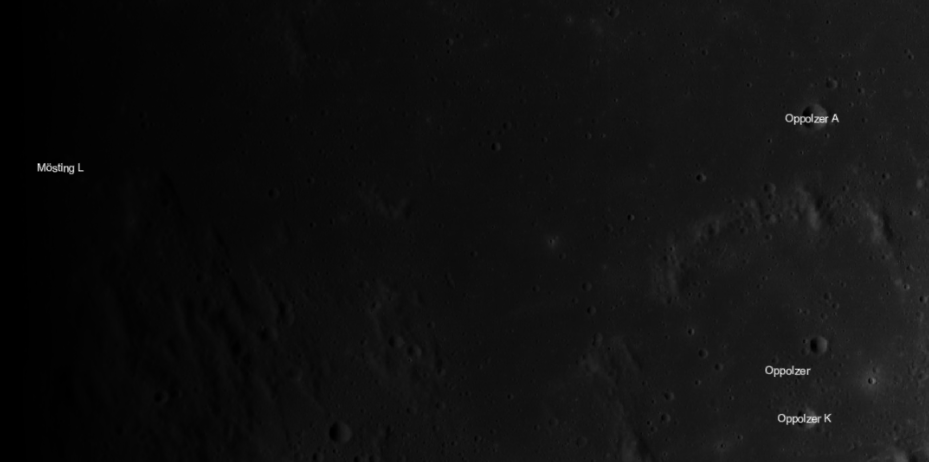
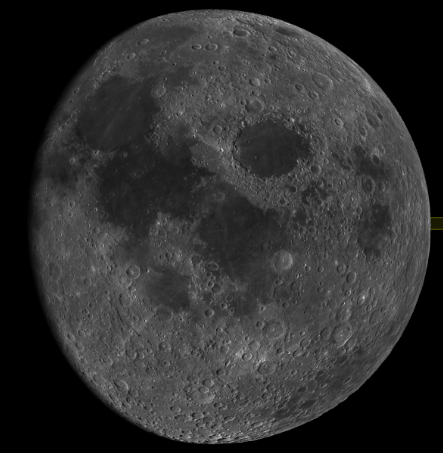
This image is one that has caught the attention of one hoax believer, let’s call him “Brian”, who has spotted the error in the Apollo 10 mission report, which suggests the photo was taken “halfway between the Earth and moon”. He spends a lot of time working out that it was more likely to have been taken at around 13:00 on the 24th. Sometimes. Brian, NASA’s technical writers got things wrong. I’ve lost count of the number of mislabelled photos in NASA reports, or even NASA images printed the wrong way round.
Perhaps more important is his claim that the 16mm magazines show an incorrect location of the terminator, and a terminator that has moved too quickly. I’ve already pointed out that what we see in 16mm footage is not necessarily the exact location of the terminator, but rather the location of the point where a specific film and camera combination fails to register the darkening lunar surface, so let’s see if we can work out if his claim about incorrect movement is true.
The magazines in question are F and G, and show the terminator on successive orbits as filmed from the LM.
This map shows the end of the film sequences, and suggests that the respective ends of magazine F (in blue) and G (in magenta) are roughly 30 km apart, which amounts to around 2 degrees of longitude. The lunar terminator should move around 30 km in that time, so there’s definitely a discrepancy there, but it’s certainly not the 5 degrees Brian claims.
So, first things first, are the ends of the film correctly located? These are the final visible frames in magazine F and G:
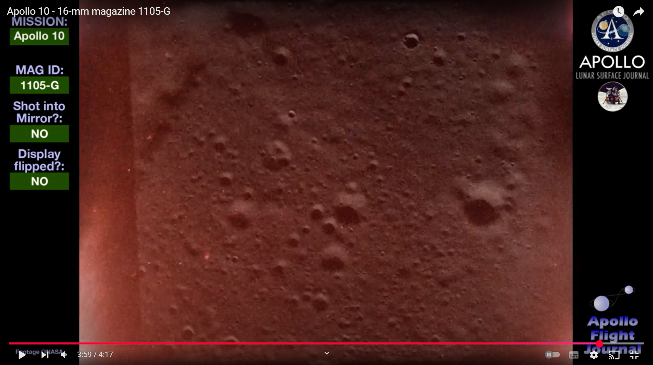
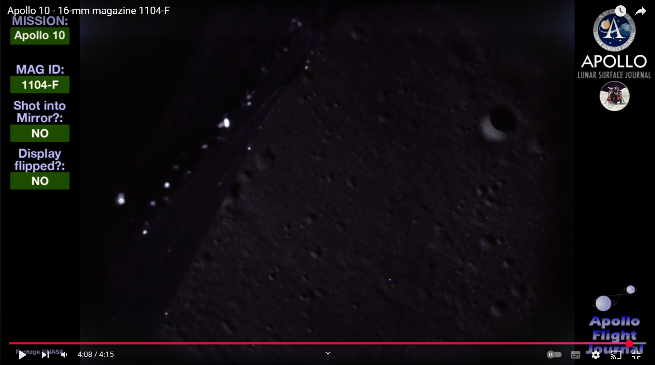
So we can definitely confirm that the two magazines end at locations that are just over 2.5 degrees apart.
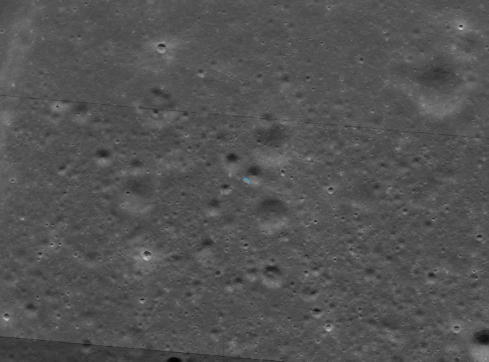
0.36164, 20.61539
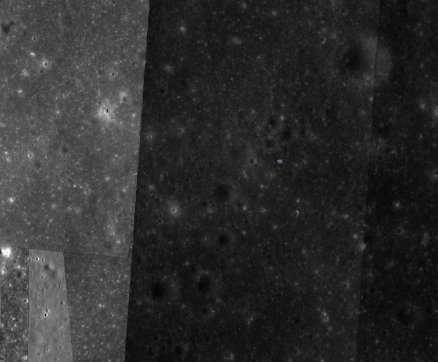
0.24546, 23.18417
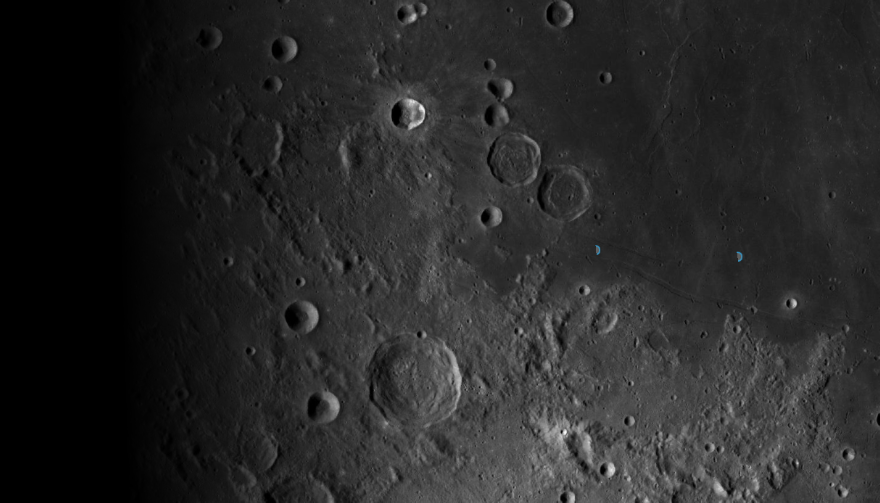
The image below shows that they are also some distance from the terminator -
So here’s the thing. Assuming we have the timing of the two magazine correct at 1 lunar orbit apart, absolutely nowhere does it state that this footage shows the lunar terminator. Here are the two entries in the photography index:


Absolutely no reference whatsoever to the terminator. Given that one of the aims of the mission was to take photos of potential landing sites, with the actual one being towards the end of those film magazines, it would seem a little pointless trying to photograph them in the dark. Looking at the craters that are visible in the 16mm footage, they are clearly lit on one side -
What Brian also needs to account for is the detail in these 16mm films that just isn’t there in pre-
What we can also learn from this particular exercise is that, even when we can’t be certain when a specific magazine has been used, we can make reasonable deductions, and that once again even over a relatively short mission the terminator changes position quite markedly. This change is recorded accurately by Apollo images and film.
It also becomes clear from the way that shadows are shown at the terminator that they are recording a three dimensional object, and not some two dimensional projection that certain sectors of the conspiracy theorists argue. We also know it’s not a small scale model, thanks to examinations of photographs on this site.
The next section starts with the first of the landing missions, Apollo 11 & 12
